Sugammadex发布后儿童住院患者数据库中的恶性高热发生率
IF 1
Q2 Nursing
Perioperative Care and Operating Room Management
Pub Date : 2024-12-26
DOI:10.1016/j.pcorm.2024.100459
引用次数: 0
摘要
目的:确定自美国食品和药物管理局批准sugammadex以来,在大量儿科患者样本中恶性高热(MH)的发生率是否发生了变化。方法确定的数据来自美国卫生与人类服务部医疗保健研究与质量局的2019年儿童住院患者数据库(Kid)。诊断为MH的患者采用《国际疾病分类》第10版代码T88.3XXA进行鉴定。比较使用卡方或费雪精确值和学生t检验或曼·惠特尼u检验。将以前来自KID样本的研究中的历史MH率与2019年KID样本中确定的比率进行比较,以评估随时间推移的变化。结果2019年儿童传染病调查中,经ICD10编码鉴定的MH共30例。(表1)总体发生率较低(0.001%)。两名诊断为MH的儿童在住院期间死亡(占MH病例的6.7%)。诊断为MH患者的平均年龄为9.6岁。在30例病例中,17例发生在未接受手术治疗的患者中。在这17例患者中,有12例被诊断为急性呼吸衰竭。接受手术治疗的患者中有13例。在接受手术的患者中,这一比例更高(0.005% vs.0.00007%, P <;0.001)。结论该地区MH发病率较低,且低于以往报道。我们推测,sugammadex的批准减少了琥珀酰胆碱的使用,从而降低了MH的发生率。在需要气管插管的非手术患者中,MH的发生率有进一步降低的潜在空间。本文章由计算机程序翻译,如有差异,请以英文原文为准。
Malignant hyperthermia incidence in the kids inpatient database after the release of Sugammadex
Aims
To determine if the incidence of Malignant Hyperthermia (MH) has changed in a large sample of pediatric patients since the US Food and Drug Administration's approval of sugammadex.
Methods
Deidentified data was obtained from the US Department of Health and Human Services Agency for Healthcare Research and Quality's 2019 Kid's Inpatient Database (KID). Patients with the diagnosis of MH were identified by the International Classification of Diseases, 10th edition code T88.3XXA. Comparisons were made using Chi square or Fisher's exact and Student's T-test or Mann Whitney U-Test as appropriate. Historical MH rates from previous studies from KID samples were compared to the rates identified in the 2019 KID sample to assess for a change overtime.
Results
There were 30 cases of MH identified by the ICD10 code in the 2019 KID. (Table 1) The overall rate was low (0.001%). Two children diagnosed with MH died during hospitalization (6.7% of MH cases). The mean age of patients diagnosed with MH was 9.6 years. Of the 30 cases, 17 occurred in patients who did not undergo an operative procedure. In 12 of these 17 patients, there was a diagnosis of acute respiratory failure. There were 13 cases among patients undergoing operative procedures. The rate was higher among patients undergoing operative procedures (0.005% vs.0.00007%, P < 0.001).
Conclusion
The incidence of MH remains low and seems lower than previous reports. We speculate the approval of sugammadex has reduced the use of succinylcholine which resulted in a decreased rate of MH. There is potentially room for a further reduction in MH incidence rate among nonoperative patients requiring tracheal intubation.
求助全文
通过发布文献求助,成功后即可免费获取论文全文。
去求助
来源期刊

Perioperative Care and Operating Room Management
Nursing-Medical and Surgical Nursing
CiteScore
1.30
自引率
0.00%
发文量
52
审稿时长
56 days
期刊介绍:
The objective of this new online journal is to serve as a multidisciplinary, peer-reviewed source of information related to the administrative, economic, operational, safety, and quality aspects of the ambulatory and in-patient operating room and interventional procedural processes. The journal will provide high-quality information and research findings on operational and system-based approaches to ensure safe, coordinated, and high-value periprocedural care. With the current focus on value in health care it is essential that there is a venue for researchers to publish articles on quality improvement process initiatives, process flow modeling, information management, efficient design, cost improvement, use of novel technologies, and management.
 求助内容:
求助内容: 应助结果提醒方式:
应助结果提醒方式:


